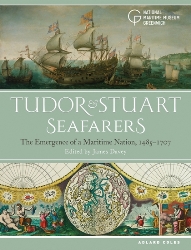 Pirates and Privateers Pirates and Privateers
The History of Maritime
Piracy
Cindy Vallar, Editor
& Reviewer
P.O. Box 425,
Keller, TX 76244-0425
    
Books for
Adults ~ History: Maritime

Tudor & Stuart Seafarers:
The Emergence of a Maritime Nation, 1485-1707
edited by James Davey
National Maritime Museum Greenwich and Adlard Coles,
2018, ISBN 978-1-4729-5676-7, US $35.00 / UK £ 25.00
Also available in other formats
    
In
conjunction with the opening of a new gallery at the
National Maritime Museum, this book highlights some
of the many artifacts found in the Tudor and Stuart
Seafarers Gallery and explores key aspects of
seafaring during the 16th and 17th centuries.
According to Dr. Kevin Fewster, the Director of the
Royal Museums Greenwich, “By looking anew at events
like the defeat of the Spanish Armada and the
English settlement of North America, some familiar
misconceptions might be overturned and difficult
moments in the nation’s past be brought into sharper
focus.” (7) Until the late 1500s, England’s primary
focus is on itself. Only after this point in time do
the English expand outward in search of
opportunities and adventure.
The exhibit encompasses the years 1485 through 1707,
and shows the changes to and effects on ships and
seafarers. At the same, it demonstrates how sea
exploration and colonial expansion impact trade,
warfare, policy, art, music, and popular culture to
forge a national identity. Initial territorial and
economic expansion, which becomes exceedingly
important after 1550, is principally wrought by
individuals rather than backed by the government.
Twelve chapters examine England’s evolution into a
maritime nation during this period of 222 years.
- ‘New Worlds’:
1485-1505 by Felipe Fernandez-Armesto
- Adventurers:
England Turns to the Sea, 1550-80 by James Davey
- The Spanish Armada
and England’s Conflict with Spain, 1585-1604 by
David Scott
- Building a Navy by
J. D. Davies
- Using the Seas and
Skies: Navigation in Early-Modern England by
Megan Barford and Louise Devoy
- Encounter and
Exploitation: The English Colonization of North
America, 1585-1615 by Laura Humphreys
- Of Profit and Loss:
The Trading World of Seventeenth-Century England
by Robert J. Blyth
- The British Civil
Wars, 1638-53 by Elaine Murphy
- Life at Sea by
Richard J. Blakemore
- The
Seventeenth-Century Anglo-Dutch Wars by Rebecca
Rideal
- A Sea of
Scoundrels: Pirates of the Stuart Era by Aaron
Jaffer
- Art and the
Maritime World, 1550-1714 by Christine Riding
Complimenting each
chapter are objects from the museum’s collection –
charts, paintings, artifacts, ship models, and
publications – that provide insightful glimpses into
the topic being discussed. Some illustrations merit
double-page spreads; all pictures are in full color.
Captions identify these objects, but these aren’t
always enlightening. For example, a teapot is
labeled as being late 17th century, but readers are
left to wonder why this particular teapot is
selected and what its provenance is.
The contributors are identified as “twelve leading
scholars” in the introduction and are quite
knowledgeable about their subjects, but no
biographical credentials are included for readers
seeking to know more about the writers. (12)
The gallery’s patron and the museum’s director
provide forewords to the book and the editor pens
both the introduction and one of the essays. Notes,
a bibliography, and an index conclude the book. In
between and woven throughout the chapters are boxed
highlights of people whose impact on English
maritime history should be known, but may not be.
Some names are well known, such as Tisquantum
(Squanto), William Shakespeare, John Cabot, Samuel
Pepys, Pocahontas, and Gráinnie O’Malley. Readers
may not be familiar with others – Diego, Lord
Effingham, Jahangir, or Richard Deane – while a few
aren’t usually associated with British seafaring,
such as Amerigo Vespucci, Vasco da Gama, and Michiel
de Ruyter.
The book tackles a number of sensitive subjects –
such as the slave trade and the spread of disease
among indigenous peoples – in part because violence
and exploitation go hand in hand with the events.
Rather than omit them from the historical narrative,
the contributors choose to incorporate them to help
readers understand why people of the past act as
they do. What the book does not do is judge;
instead, readers are provided with a well-rounded
explanation from which they can decide for
themselves who and what are good or bad, right or
wrong.
Chapter 11 will be of particular interest to readers
of Pirates and Privateers. During the Tudor
and Stuart periods, many people are called “pirates”
and pillaging ships is even encouraged at times by
people in authority. Piracy plays a key role in
early English history and doesn’t cease to be a
problem until the third decade of the 17th century.
Among the topics explored here are women’s roles in
domestic piracy, merchant reprisals, privateering,
the Barbary corsairs (both attacks on places like
Baltimore, Ireland and Englishmen who become renegadoes,
such as John Ward), and the buccaneers (Henry
Morgan, William Dampier, and Henry Avery). To my
surprise, one man not mentioned in connection with
the renegadoes is Sir Henry Mainwaring.
Tudor & Stuart Seafarers is a highly
readable and entertaining book, and it’s impossible
to come away from it without learning something new.

Click to contact me
Background image compliments
of Anke's Graphics |

